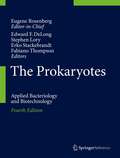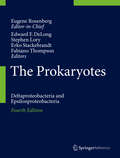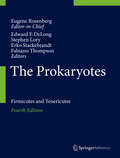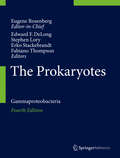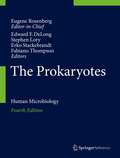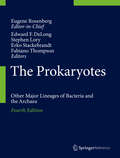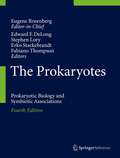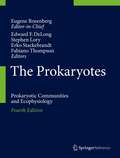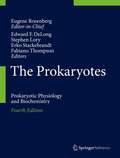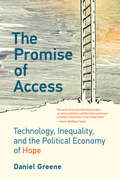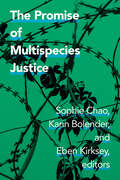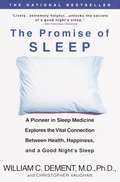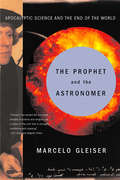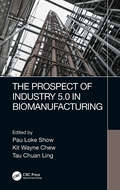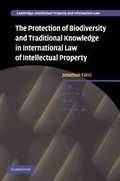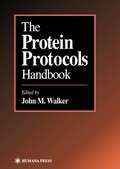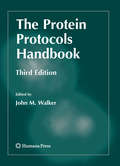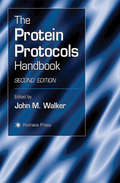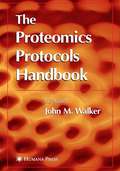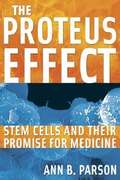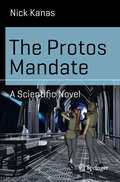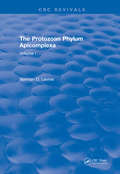- Table View
- List View
The Prokaryotes: Applied Bacteriology and Biotechnology
by Eugene Rosenberg Edward F. Delong Fabiano Thompson Stephen Lory Erko StackebrandtThe Prokaryotes is a comprehensive, multi-authored, peer reviewed reference work on Bacteria and Achaea. This fourth edition of The Prokaryotes is organized to cover all taxonomic diversity, using the family level to delineate chapters.<P><P> Different from other resources, this new Springer product includes not only taxonomy, but also prokaryotic biology and technology of taxa in a broad context. Technological aspects highlight the usefulness of prokaryotes in processes and products, including biocontrol agents and as genetics tools.<P><P> The content of the expanded fourth edition is divided into two parts: Part 1 contains review chapters dealing with the most important general concepts in molecular, applied and general prokaryote biology; Part 2 describes the known properties of specific taxonomic groups. Two completely new sections have been added to Part 1: bacterial communities and human bacteriology. The bacterial communities section reflects the growing realization that studies on pure cultures of bacteria have led to an incomplete picture of the microbial world for two fundamental reasons: the vast majority of bacteria in soil, water and associated with biological tissues are currently not culturable, and that an understanding of microbial ecology requires knowledge on how different bacterial species interact with each other in their natural environment. The new section on human microbiology deals with bacteria associated with healthy humans and bacterial pathogenesis. Each of the major human diseases caused by bacteria is reviewed, from identifying the pathogens by classical clinical and non-culturing techniques to the biochemical mechanisms of the disease process.<P> The 4th edition of The Prokaryotes is the most complete resource on the biology of prokaryotes.<P> The following volumes are published consecutively within the 4th Edition:<P> Prokaryotic Biology and Symbiotic Associations<P> Prokaryotic Communities and EcophysiologyProkaryotic Physiology and Biochemistry<P> Applied Bacteriology and Biotechnology<P> Human Microbiology<P> Actinobacteria<P> Firmicutes<P> Alphaproteobacteria and Betaproteobacteria<P> Gammaproteobacteria<P> Deltaproteobacteria and Epsilonproteobacteria<P> Other Major Lineages of Bacteria and the Archaea<P>
The Prokaryotes: Deltaproteobacteria and Epsilonproteobacteria
by Eugene Rosenberg Edward F. Delong Fabiano Thompson Stephen Lory Erko StackebrandtThe Prokaryotes is a comprehensive, multi-authored, peer reviewed reference work on Bacteria and Achaea. This fourth edition of The Prokaryotes is organized to cover all taxonomic diversity, using the family level to delineate chapters.<P><P> Different from other resources, this new Springer product includes not only taxonomy, but also prokaryotic biology and technology of taxa in a broad context. Technological aspects highlight the usefulness of prokaryotes in processes and products, including biocontrol agents and as genetics tools.<P><P> The content of the expanded fourth edition is divided into two parts: Part 1 contains review chapters dealing with the most important general concepts in molecular, applied and general prokaryote biology; Part 2 describes the known properties of specific taxonomic groups. Two completely new sections have been added to Part 1: bacterial communities and human bacteriology. The bacterial communities section reflects the growing realization that studies on pure cultures of bacteria have led to an incomplete picture of the microbial world for two fundamental reasons: the vast majority of bacteria in soil, water and associated with biological tissues are currently not culturable, and that an understanding of microbial ecology requires knowledge on how different bacterial species interact with each other in their natural environment. The new section on human microbiology deals with bacteria associated with healthy humans and bacterial pathogenesis. Each of the major human diseases caused by bacteria is reviewed, from identifying the pathogens by classical clinical and non-culturing techniques to the biochemical mechanisms of the disease process.<P> The 4th edition of The Prokaryotes is the most complete resource on the biology of prokaryotes.<P> The following volumes are published consecutively within the 4th Edition:<P> Prokaryotic Biology and Symbiotic Associations<P> Prokaryotic Communities and EcophysiologyProkaryotic Physiology and Biochemistry<P> Applied Bacteriology and Biotechnology<P> Human Microbiology<P> Actinobacteria<P> Firmicutes<P> Alphaproteobacteria and Betaproteobacteria<P> Gammaproteobacteria<P> Deltaproteobacteria and Epsilonproteobacteria<P> Other Major Lineages of Bacteria and the Archaea<P>
The Prokaryotes: Firmicutes and Tenericutes
by Eugene Rosenberg Edward F. Delong Fabiano Thompson Stephen Lory Erko StackebrandtThe Prokaryotes is a comprehensive, multi-authored, peer reviewed reference work on Bacteria and Achaea. This fourth edition of The Prokaryotes is organized to cover all taxonomic diversity, using the family level to delineate chapters.<P><P> Different from other resources, this new Springer product includes not only taxonomy, but also prokaryotic biology and technology of taxa in a broad context. Technological aspects highlight the usefulness of prokaryotes in processes and products, including biocontrol agents and as genetics tools.<P><P> The content of the expanded fourth edition is divided into two parts: Part 1 contains review chapters dealing with the most important general concepts in molecular, applied and general prokaryote biology; Part 2 describes the known properties of specific taxonomic groups. Two completely new sections have been added to Part 1: bacterial communities and human bacteriology. The bacterial communities section reflects the growing realization that studies on pure cultures of bacteria have led to an incomplete picture of the microbial world for two fundamental reasons: the vast majority of bacteria in soil, water and associated with biological tissues are currently not culturable, and that an understanding of microbial ecology requires knowledge on how different bacterial species interact with each other in their natural environment. The new section on human microbiology deals with bacteria associated with healthy humans and bacterial pathogenesis. Each of the major human diseases caused by bacteria is reviewed, from identifying the pathogens by classical clinical and non-culturing techniques to the biochemical mechanisms of the disease process.<P> The 4th edition of The Prokaryotes is the most complete resource on the biology of prokaryotes.<P> The following volumes are published consecutively within the 4th Edition:<P> Prokaryotic Biology and Symbiotic Associations<P> Prokaryotic Communities and EcophysiologyProkaryotic Physiology and Biochemistry<P> Applied Bacteriology and Biotechnology<P> Human Microbiology<P> Actinobacteria<P> Firmicutes<P> Alphaproteobacteria and Betaproteobacteria<P> Gammaproteobacteria<P> Deltaproteobacteria and Epsilonproteobacteria<P> Other Major Lineages of Bacteria and the Archaea<P>
The Prokaryotes: Gammaproteobacteria
by Eugene Rosenberg Edward F. Delong Fabiano Thompson Stephen Lory Erko StackebrandtThe Prokaryotes is a comprehensive, multi-authored, peer reviewed reference work on Bacteria and Achaea. This fourth edition of The Prokaryotes is organized to cover all taxonomic diversity, using the family level to delineate chapters.<P><P> Different from other resources, this new Springer product includes not only taxonomy, but also prokaryotic biology and technology of taxa in a broad context. Technological aspects highlight the usefulness of prokaryotes in processes and products, including biocontrol agents and as genetics tools.<P><P> The content of the expanded fourth edition is divided into two parts: Part 1 contains review chapters dealing with the most important general concepts in molecular, applied and general prokaryote biology; Part 2 describes the known properties of specific taxonomic groups. Two completely new sections have been added to Part 1: bacterial communities and human bacteriology. The bacterial communities section reflects the growing realization that studies on pure cultures of bacteria have led to an incomplete picture of the microbial world for two fundamental reasons: the vast majority of bacteria in soil, water and associated with biological tissues are currently not culturable, and that an understanding of microbial ecology requires knowledge on how different bacterial species interact with each other in their natural environment. The new section on human microbiology deals with bacteria associated with healthy humans and bacterial pathogenesis. Each of the major human diseases caused by bacteria is reviewed, from identifying the pathogens by classical clinical and non-culturing techniques to the biochemical mechanisms of the disease process.<P> The 4th edition of The Prokaryotes is the most complete resource on the biology of prokaryotes.<P> The following volumes are published consecutively within the 4th Edition:<P> Prokaryotic Biology and Symbiotic Associations<P> Prokaryotic Communities and EcophysiologyProkaryotic Physiology and Biochemistry<P> Applied Bacteriology and Biotechnology<P> Human Microbiology<P> Actinobacteria<P> Firmicutes<P> Alphaproteobacteria and Betaproteobacteria<P> Gammaproteobacteria<P> Deltaproteobacteria and Epsilonproteobacteria<P> Other Major Lineages of Bacteria and the Archaea<P>
The Prokaryotes: Human Microbiology
by Eugene Rosenberg Edward F. Delong Fabiano Thompson Stephen Lory Erko StackebrandtThe Prokaryotes is a comprehensive, multi-authored, peer reviewed reference work on Bacteria and Achaea. This fourth edition of The Prokaryotes is organized to cover all taxonomic diversity, using the family level to delineate chapters.<P><P> Different from other resources, this new Springer product includes not only taxonomy, but also prokaryotic biology and technology of taxa in a broad context. Technological aspects highlight the usefulness of prokaryotes in processes and products, including biocontrol agents and as genetics tools.<P><P> The content of the expanded fourth edition is divided into two parts: Part 1 contains review chapters dealing with the most important general concepts in molecular, applied and general prokaryote biology; Part 2 describes the known properties of specific taxonomic groups. Two completely new sections have been added to Part 1: bacterial communities and human bacteriology. The bacterial communities section reflects the growing realization that studies on pure cultures of bacteria have led to an incomplete picture of the microbial world for two fundamental reasons: the vast majority of bacteria in soil, water and associated with biological tissues are currently not culturable, and that an understanding of microbial ecology requires knowledge on how different bacterial species interact with each other in their natural environment. The new section on human microbiology deals with bacteria associated with healthy humans and bacterial pathogenesis. Each of the major human diseases caused by bacteria is reviewed, from identifying the pathogens by classical clinical and non-culturing techniques to the biochemical mechanisms of the disease process.<P> The 4th edition of The Prokaryotes is the most complete resource on the biology of prokaryotes.<P> The following volumes are published consecutively within the 4th Edition:<P> Prokaryotic Biology and Symbiotic Associations<P> Prokaryotic Communities and EcophysiologyProkaryotic Physiology and Biochemistry<P> Applied Bacteriology and Biotechnology<P> Human Microbiology<P> Actinobacteria<P> Firmicutes<P> Alphaproteobacteria and Betaproteobacteria<P> Gammaproteobacteria<P> Deltaproteobacteria and Epsilonproteobacteria<P> Other Major Lineages of Bacteria and the Archaea<P>
The Prokaryotes: Other Major Lineages of Bacteria and The Archaea
by Eugene Rosenberg Edward F. Delong Fabiano Thompson Stephen Lory Erko StackebrandtThe Prokaryotes is a comprehensive, multi-authored, peer reviewed reference work on Bacteria and Achaea. This fourth edition of The Prokaryotes is organized to cover all taxonomic diversity, using the family level to delineate chapters.<P><P> Different from other resources, this new Springer product includes not only taxonomy, but also prokaryotic biology and technology of taxa in a broad context. Technological aspects highlight the usefulness of prokaryotes in processes and products, including biocontrol agents and as genetics tools.<P><P> The content of the expanded fourth edition is divided into two parts: Part 1 contains review chapters dealing with the most important general concepts in molecular, applied and general prokaryote biology; Part 2 describes the known properties of specific taxonomic groups. Two completely new sections have been added to Part 1: bacterial communities and human bacteriology. The bacterial communities section reflects the growing realization that studies on pure cultures of bacteria have led to an incomplete picture of the microbial world for two fundamental reasons: the vast majority of bacteria in soil, water and associated with biological tissues are currently not culturable, and that an understanding of microbial ecology requires knowledge on how different bacterial species interact with each other in their natural environment. The new section on human microbiology deals with bacteria associated with healthy humans and bacterial pathogenesis. Each of the major human diseases caused by bacteria is reviewed, from identifying the pathogens by classical clinical and non-culturing techniques to the biochemical mechanisms of the disease process.<P> The 4th edition of The Prokaryotes is the most complete resource on the biology of prokaryotes.<P> The following volumes are published consecutively within the 4th Edition:<P> Prokaryotic Biology and Symbiotic Associations<P> Prokaryotic Communities and EcophysiologyProkaryotic Physiology and Biochemistry<P> Applied Bacteriology and Biotechnology<P> Human Microbiology<P> Actinobacteria<P> Firmicutes<P> Alphaproteobacteria and Betaproteobacteria<P> Gammaproteobacteria<P> Deltaproteobacteria and Epsilonproteobacteria<P> Other Major Lineages of Bacteria and the Archaea<P>
The Prokaryotes: Prokaryotic Biology, Communities and Ecophysiology
by Eugene Rosenberg Edward F. Delong Fabiano Thompson Stephen Lory Erko StackebrandtThe Prokaryotes is a comprehensive, multi-authored, peer reviewed reference work on Bacteria and Achaea. This fourth edition of The Prokaryotes is organized to cover all taxonomic diversity, using the family level to delineate chapters.<P><P> Different from other resources, this new Springer product includes not only taxonomy, but also prokaryotic biology and technology of taxa in a broad context. Technological aspects highlight the usefulness of prokaryotes in processes and products, including biocontrol agents and as genetics tools.<P><P> The content of the expanded fourth edition is divided into two parts: Part 1 contains review chapters dealing with the most important general concepts in molecular, applied and general prokaryote biology; Part 2 describes the known properties of specific taxonomic groups. Two completely new sections have been added to Part 1: bacterial communities and human bacteriology. The bacterial communities section reflects the growing realization that studies on pure cultures of bacteria have led to an incomplete picture of the microbial world for two fundamental reasons: the vast majority of bacteria in soil, water and associated with biological tissues are currently not culturable, and that an understanding of microbial ecology requires knowledge on how different bacterial species interact with each other in their natural environment. The new section on human microbiology deals with bacteria associated with healthy humans and bacterial pathogenesis. Each of the major human diseases caused by bacteria is reviewed, from identifying the pathogens by classical clinical and non-culturing techniques to the biochemical mechanisms of the disease process.<P> The 4th edition of The Prokaryotes is the most complete resource on the biology of prokaryotes.<P> The following volumes are published consecutively within the 4th Edition:<P> Prokaryotic Biology and Symbiotic Associations<P> Prokaryotic Communities and EcophysiologyProkaryotic Physiology and Biochemistry<P> Applied Bacteriology and Biotechnology<P> Human Microbiology<P> Actinobacteria<P> Firmicutes<P> Alphaproteobacteria and Betaproteobacteria<P> Gammaproteobacteria<P> Deltaproteobacteria and Epsilonproteobacteria<P> Other Major Lineages of Bacteria and the Archaea<P>
The Prokaryotes: Prokaryotic Communities and Ecophysiology
by Eugene Rosenberg Edward F. Delong Fabiano Thompson Stephen Lory Erko StackebrandtThe Prokaryotes is a comprehensive, multi-authored, peer reviewed reference work on Bacteria and Achaea. This fourth edition of The Prokaryotes is organized to cover all taxonomic diversity, using the family level to delineate chapters.<P><P> Different from other resources, this new Springer product includes not only taxonomy, but also prokaryotic biology and technology of taxa in a broad context. Technological aspects highlight the usefulness of prokaryotes in processes and products, including biocontrol agents and as genetics tools.<P><P> The content of the expanded fourth edition is divided into two parts: Part 1 contains review chapters dealing with the most important general concepts in molecular, applied and general prokaryote biology; Part 2 describes the known properties of specific taxonomic groups. Two completely new sections have been added to Part 1: bacterial communities and human bacteriology. The bacterial communities section reflects the growing realization that studies on pure cultures of bacteria have led to an incomplete picture of the microbial world for two fundamental reasons: the vast majority of bacteria in soil, water and associated with biological tissues are currently not culturable, and that an understanding of microbial ecology requires knowledge on how different bacterial species interact with each other in their natural environment. The new section on human microbiology deals with bacteria associated with healthy humans and bacterial pathogenesis. Each of the major human diseases caused by bacteria is reviewed, from identifying the pathogens by classical clinical and non-culturing techniques to the biochemical mechanisms of the disease process.<P> The 4th edition of The Prokaryotes is the most complete resource on the biology of prokaryotes.<P> The following volumes are published consecutively within the 4th Edition:<P> Prokaryotic Biology and Symbiotic Associations<P> Prokaryotic Communities and EcophysiologyProkaryotic Physiology and Biochemistry<P> Applied Bacteriology and Biotechnology<P> Human Microbiology<P> Actinobacteria<P> Firmicutes<P> Alphaproteobacteria and Betaproteobacteria<P> Gammaproteobacteria<P> Deltaproteobacteria and Epsilonproteobacteria<P> Other Major Lineages of Bacteria and the Archaea<P>
The Prokaryotes: Symbiosis and Human Microbiology
by Eugene Rosenberg Edward F. Delong Fabiano Thompson Stephen Lory Erko StackebrandtThe Prokaryotes is a comprehensive, multi-authored, peer reviewed reference work on Bacteria and Achaea. This fourth edition of The Prokaryotes is organized to cover all taxonomic diversity, using the family level to delineate chapters.<P><P> Different from other resources, this new Springer product includes not only taxonomy, but also prokaryotic biology and technology of taxa in a broad context. Technological aspects highlight the usefulness of prokaryotes in processes and products, including biocontrol agents and as genetics tools.<P><P> The content of the expanded fourth edition is divided into two parts: Part 1 contains review chapters dealing with the most important general concepts in molecular, applied and general prokaryote biology; Part 2 describes the known properties of specific taxonomic groups. Two completely new sections have been added to Part 1: bacterial communities and human bacteriology. The bacterial communities section reflects the growing realization that studies on pure cultures of bacteria have led to an incomplete picture of the microbial world for two fundamental reasons: the vast majority of bacteria in soil, water and associated with biological tissues are currently not culturable, and that an understanding of microbial ecology requires knowledge on how different bacterial species interact with each other in their natural environment. The new section on human microbiology deals with bacteria associated with healthy humans and bacterial pathogenesis. Each of the major human diseases caused by bacteria is reviewed, from identifying the pathogens by classical clinical and non-culturing techniques to the biochemical mechanisms of the disease process.<P> The 4th edition of The Prokaryotes is the most complete resource on the biology of prokaryotes.<P> The following volumes are published consecutively within the 4th Edition:<P> Prokaryotic Biology and Symbiotic Associations<P> Prokaryotic Communities and EcophysiologyProkaryotic Physiology and Biochemistry<P> Applied Bacteriology and Biotechnology<P> Human Microbiology<P> Actinobacteria<P> Firmicutes<P> Alphaproteobacteria and Betaproteobacteria<P> Gammaproteobacteria<P> Deltaproteobacteria and Epsilonproteobacteria<P> Other Major Lineages of Bacteria and the Archaea<P>
The Prometheus Crisis
by Thomas N. Scortia Frank M. RobinsonIn northern California, Project Prometheus, a five-billion-dollar nuclear power station-the largest in the world -has reached the final critical stages of thermal equilibrium. Momentarily, the President of the United States is going to announce to the nation that Prometheus has been activated and that this country has the solution to the energy crisis within its grasp. But deep within the reactor's central core, the factor of human error sparks that one chance in 300,000,000: Prometheus unleashes a hideous nuclear holocaust that no one can reverse.... Thomas N. Scortia and Frank M. Robinson, whose masterful and chilling ways with suspense are currently on view in The Towering Inferno, the film based in part on their first novel, The Glass Inferno, again deliver a taut story that could come from tomorrow's front pages: a story of the men and women caught up in a horrifying race in which science and technology are ultimately pushed too far and too fast.
The Promise of Access: Technology, Inequality, and the Political Economy of Hope
by Daniel GreeneWhy simple technological solutions to complex social issues continue to appeal to politicians and professionals who should (and often do) know better.Why do we keep trying to solve poverty with technology? What makes us feel that we need to learn to code--or else? In The Promise of Access, Daniel Greene argues that the problem of poverty became a problem of technology in order to manage the contradictions of a changing economy. Greene shows how the digital divide emerged as a policy problem and why simple technological solutions to complex social issues continue to appeal to politicians and professionals who should (and often do) know better.
The Promise of Contemporary Primatology (New Biological Anthropology)
by Erin P. RileyThis book argues for a contemporary primatology that recognizes humans as integral components in the ecologies of primates. This contemporary primatology uses a broadened theoretical lens and methodological toolkit to study primate behavior and ecology in increasingly anthropogenic contexts and seeks points of intersection and spaces for collaborative exchange across the natural sciences, social sciences, and humanities. The book begins by exploring the American tradition of anthropology, providing historical and disciplinary context for the emergence of field primatology and how it became a part of this tradition. It then examines how primatology transformed into a field dominated by evolutionary approaches and highlights how the increasingly anthropogenic environments in which primates live present opportunities to understand primate adaptability at work. In doing so, it explores how an extended evolutionary approach can help explain behavioral variation in these contemporary environments. Focus is then given to the ethnoprimatological approach, a contemporary approach that provides a pluralistic framework, drawing from the natural and social sciences and humanities, needed to study human-primate coexistence in the Anthropocene. Finally, the book considers how such a crossing of disciplines can inform primate conservation in the future. An important interdisciplinary reassessment, this book will be of significant interest to primatologists, biological anthropologists, and scholars of anthropology more generally, as well as evolutionary and conservation biologists.
The Promise of Multispecies Justice
by Sophie Chao, Karin Bolender, and Eben KirkseyWhat are the possibilities for multispecies justice? How do social justice struggles intersect with the lives of animals, plants, and other creatures? Leading thinkers in anthropology, geography, philosophy, speculative fiction, poetry, and contemporary art answer these questions from diverse grounded locations. In America, Indigenous peoples and prisoners are decolonizing multispecies relations in unceded territory and carceral landscapes. Small justices are emerging in Tanzanian markets, near banana plantations in the Philippines, and in abandoned buildings of Azerbaijan as people navigate relations with feral dogs, weeds, rats, and pesticides. Conflicts over rights of nature are intensifying in Colombia’s Amazon. Specters of justice are emerging in India, while children in Micronesia memorialize extinct bird species. Engaging with ideas about environmental justice, restorative justice, and other species of justice, The Promise of Multispecies Justice holds open the possibility of flourishing in multispecies worlds, present and to come.Contributors. Karin Bolender, Sophie Chao, M. L. Clark, Radhika Govindrajan, Zsuzsanna Dominika Ihar, Noriko Ishiyama, Eben Kirksey, Elizabeth Lara, Jia Hui Lee, Kristina Lyons, Michael Marder, Alyssa Paredes, Craig Santos Perez, Kim TallBear
The Promise of Nostalgia: Reminiscence, Longing and Hope in Contemporary American Culture (Routledge Research in Anticipation and Futures)
by Nicola SayersThe Promise of Nostalgia analyses a range of texts – including The Virgin Suicides, both the novel by Jeffrey Eugenides’ and Sofia Coppola’s screen adaptation, photography of Detroit’s ‘abandoned spaces’, and blogger Tavi Gevinson's media output – to explore nostalgia as a prominent affect in contemporary American cultural production. Counter to the prevalent caricature of nostalgia as anti-future, the book proposes a more nuanced reading of its stakes and meanings. Instead of understanding it as evidence of the absence of utopia it contends that there is a masked utopian impulse in this nostalgia ‘mode’ and critical potential in what has typically been dismissed as ideological. This book will be of interest to scholars, graduate students and upper-level undergraduate students interested in contemporary culture, cultural theory, media studies, the Frankfurt School, utopian studies and American literature and culture.
The Promise of Sleep: A Pioneer in Sleep Medicine Explores the Vital Connection Between Health, Happiness, and a Good Night's Sleep
by William C. Dement Christopher VaughanSleep better, live longer with the groundbreaking information and step-by-step program in this revolutionary book. Healthful sleep has been empirically proven to be the single most important factor in predicting longevity, more influential than diet, exercise, or heredity. And yet we are a sleep-sick society, ignorant of the facts of sleep--and the price of sleep deprivation. In this groundbreaking book, based on decades of study on the frontiers of sleep science, Dr. William Dement, founder and director of the Stanford University Sleep Research Center, explains what happens when we sleep, when we don't, and how we can reclaim the most powerful--and underrated--health miracle of all. Taking us on a fascinating tour of our sleeping body and mind, Dr. Dement reveals the price we have paid for ignoring sleep--an epidemic of heart disease, 33 percent of traffic-fatigue-related accidents, and immeasurable mental and psychological disadvantages. And he offers a hands-on prescription for vibrant good health and longevity, including... self-tests to determine how much sleep you really need... the role of prescription and over-the-counter sleeping aids... the latest research on how sleep affects the immune system... how to combat insomnia, snoring, and jet lag... plus information on sleep disorder clinics nationwide, Web sites, and more. Taking readers on a fascinating tour of our sleeping body and mind, Dr. William C. Dement reveals the price paid for ignoring sleep--an epidemic of heart disease, traffic-fatigue-related accidents (responsible for a full third of all traffic accidents), and immeasurable mental and psychological disadvantages. Offering a hands-on prescription for vibrant good health and longevity, THE PROMISE OF SLEEP includes self-tests to determine how much sleep you really need, full information on the role of prescription and over-the-counter sleeping aids, the latest research on how sleep affects the immune system, helpful methods for combating insomnia, snoring, and jet lag, plus information on sleep disorder clinics nationwide, sleep disorder Web sites, and more.
The Prophet and the Astronomer: Apocalyptic Science and the End of the World
by Marcelo Gleiser"An intellectual accomplishment that illuminates the magic and the wisdom of the heavens above."--Kirkus Reviews "Tracing our contemplation of the cosmos from the big bang to the big crunch" (The New Yorker), Marcelo Gleiser explores the shared quest of ancient prophets and today's astronomers to explain the strange phenomena of our skies--from the apocalypse foretold in Revelations to modern science's ongoing identification of multiple cataclysmic threats, including the impact of comets and asteroids on earthly life, the likelihood of future collisions, the meaning of solar eclipses and the death of stars, the implications of black holes for time travel, and the ultimate fate of the universe and time. Presenting insights to cosmological science and apocalyptic philosophy in an "easily accessible" (Library Journal) style, Gleiser is "a rare astrophysicist as comfortable quoting Scripture as explaining formulas" (Booklist). K. C. Cole praises his ability to "[work] the entwined threads of science and religion into a vision of 'the end' that is strangely comforting and inspiring."
The Prospect of Industry 5.0 in Biomanufacturing
by Pau Loke ShowThis is the first book to present the idea of Industry 5.0 in biomanufacturing and bioprocess engineering, both upstream and downstream. The Prospect of Industry 5.0 in Biomanufacturing details the latest technologies and how they can be used efficiently and explains process analysis from an engineering point of view. In addition, it covers applications and challenges. FEATURES Describes the previous Industrial Revolution, current Industry 4.0, and how new technologies will transition toward Industry 5.0 Explains how Industry 5.0 can be applied in biomanufacturing Demonstrates new technologies catered to Industry 5.0 Uses worked examples related to biological systems This book enables readers in industry and academia working in the biomanufacturing engineering sector to understand current trends and future directions in this field.
The Protection of Biodiversity and Traditional Knowledge in International Law of Intellectual Property
by Jonathan CurciAs its economic potential has expanded rapidly, intellectual property has become a subject of front-rank legal importance. Cambridge Intellectual Property and Information Law is a series of monograph studies of major current issues in intellectual property. Each volume contains a mix of international, European, comparative and national law, making this a highly significant series for practitioners, judges and academic researchers in many countries.
The Protein Protocols Handbook
by John M. WalkerIn The Protein Protocols Handbook, I have attempted to provide a cross-section of analytical techniques commonly used for proteins and peptides, thus providing a benchtop manual and guide both for those who are new to the protein chemistry laboratory and for those more established workers who wish to use a technique for the first time. We each, of course, have our own favorite, commonly used gel system, g- staining method, blotting method, and so on; I'm sure you will find yours here. However, I have also described a variety of alternatives for many of these techniques; though they may not be superior to the methods you commonly use, they may nevertheless be more appropriate in a particular situation. Only by knowing the range of techniques that are available to you, and the strengths and limitations of these techniques, will you be able to choose the method that best suits your purpose.
The Protein Protocols Handbook
by John M. WalkerThis greatly enhanced second edition introduces 60 critically important new chapters dealing with topics and techniques that have emerged since the first edition, as well as significantly updating the remaining articles. The new chapters cover with many rapidly developing areas, particularly the application of mass spectrometry in protein characterization, as well as the now well-established 2-D PAGE technique in proteomics. The section on glycoprotein analysis has also been significantly expanded, and methods for the production of single-chain and phage-displayed antibodies have been added to the section on antibodies. Each readily reproducible method follows the highly praised format of the Methods in Molecular BiologyTM series, offering a concise summary of its basic theory, a complete materials list, a step-by-step protocol for its successful execution, and extensive notes on avoiding pitfalls and on modifying the method to function within your own experimental circumstances.
The Protein Protocols Handbook, 2nd Edition
by John M. WalkerThis greatly enhanced second edition introduces 60 critically important new chapters dealing with topics and techniques that have emerged since the first edition, as well as significantly updating the remaining articles. The new chapters cover with many rapidly developing areas, particularly the application of mass spectrometry in protein characterization, as well as the now well-established 2-D PAGE technique in proteomics. The section on glycoprotein analysis has also been significantly expanded, and methods for the production of single-chain and phage-displayed antibodies have been added to the section on antibodies. Each readily reproducible method follows the highly praised format of the Methods in Molecular BiologyTM series, offering a concise summary of its basic theory, a complete materials list, a step-by-step protocol for its successful execution, and extensive notes on avoiding pitfalls and on modifying the method to function within your own experimental circumstances.
The Proteomics Protocols Handbook
by John M. WalkerHands-on researchers describe in step-by-step detail 73 proven laboratory methods and bioinformatics tools essential for analysis of the proteome. These cutting-edge techniques address such important tasks as sample preparation, 2D-PAGE, gel staining, mass spectrometry, and post-translational modification. There are also readily reproducible methods for protein expression profiling, identifying protein-protein interactions, and protein chip technology, as well as a range of newly developed methodologies for determining the structure and function of a protein. The bioinformatics tools include those for analyzing 2D-GEL patterns, protein modeling, and protein identification. All laboratory-based protocols follow the successful Methods in Molecular BiologyTM series format, each offering step-by-step laboratory instructions, an introduction outlining the principle behind the technique, lists of the necessary equipment and reagents, and tips on troubleshooting and avoiding known pitfalls.
The Proteus Effect
by Ann B. ParsonStem cells could be the key that unlocks cures to scores of diseases and illnesses. Their story is at once compelling, controversial, and remarkable. Part detective story, part medical history, The Proteus Effect recounts the events leading up to the discovery of stem cells and their incredible potential for the future of medicine. What exactly are these biological wonders - these things called stem cells? They may be tiny, but their impact is earth shaking, generating excitement among medical researchers - and outright turmoil in political circles. They are reported to be nothing short of miraculous. But they have also incited fear and mistrust in many. Indeed, recent research on stem cells raises important questions as rapidly as it generates new discoveries. The power of stem cells rests in their unspecialized but marvelously flexible nature. They are the clay of life waiting for the cellular signal that will coax them into taking on the shape of the beating cells of the heart muscle or the insulin-producing cells of the pancreas. With a wave of our medical magic wand, it's possible that stem cells could be used to effectively treat (even cure) diseases such as Parkinson's disease, diabetes, heart disease, autoimmune disorders, and even baldness. But should scientists be allowed to pick apart four-day-old embryos in order to retrieve stem cells? And when stem cells whisper to us of immortality - they can divide and perpetuate new cells indefinitely - how do we respond? Stem cells are forcing us to not only reexamine how we define the beginning of life but how we come to terms with the end of life as well. Meticulously researched, artfully balanced, and engagingly told, Ann Parson chronicles a scientific discovery in progress, exploring the ethical debates, describing the current research, and hinting of a spectacular new era in medicine. The Proteus Effect is as timely as it is riveting.
The Protos Mandate
by Nick KanasIn the 25th Century, the effects of overpopulation and global warming on Earth have led to the formation of human colonies on the Moon, Mars and elsewhere in the Solar System, yet the limited number of viable places forces humanity to look to the stars. A crash program has been developed to send Protos 1, a giant multigenerational star ship, to a newly discovered Earth-like planet orbiting a nearby star. The plan is for awake crewmembers to run the ship and for people in suspended animation to be roused before planet fall to use their skills in exploration and colony formation. To fulfill the goals of the mission and ensure that the in-flight population does not deplete the limited resources, the Protos Mandate is set up to govern a tightly controlled social system for the duration of the journey, which will take several generations. But problems threaten to sabotage the mission during its launch and transit and what finally awaits the crewmembers shocks them in an unpredictable way. This novel chronicles the trials and tribulations of this epic first interstellar mission. The scientific appendix at the end of the book discusses the challenges of such an interstellar mission based on an extensive literature review and it links these challenges to specific episodes in the novel. Issues that are considered include interstellar propulsion systems, economic considerations of interstellar flight, psychological and sociological factors inherent in a multigenerational space mission, problems with suspended animation, current knowledge of exoplanets and issues related to colonizing a distant planet and the possible discovery of extraterrestrial life. A history of interstellar missions in science fiction is also reviewed. Nick Kanas is an Emeritus Professor of Psychiatry at the University of California, San Francisco, where he directed the group therapy training program. For over 20 years he conducted research in group therapy and for nearly 20 years after that he was the Principal Investigator of NASA-funded research on astronauts and cosmonauts. He is the co-author of Space Psychology and Psychiatry, which won the 2004 International Academy of Astronautics Life Science Book Award. Dr. Kanas has presented talks on space psychology and on celestial mapping at several regional and World Con science fiction conventions. He has been an amateur astronomer for over 50 years and is an avid reader of science fiction. He is also the author of Star Maps: History, Artistry and Cartography, Solar System Maps: From Antiquity to the Space Age, and the science fiction novel The New Martians, all published by Springer.
The Protozoan Phylum Apicomplexa: Volume 1
by Norman D. LevineAbout the turn of the century the Apicomplexa plus some other groups were called Sporozoa. With the advent of the electron microscope, it was realized that most "Sporozoa" have an apical complex; those which do not (the Microspora, Myxozoa, and Ascetospora) were removed and the name Apicomplexa was put forward by Dr. Levine in 1970. Most of the important Apicomplexa fall into five main groups: the gregarines, haemogregarines (about which there is relatively little known), coccidia, haemosporids, and piroplasms. These two volumes classify, list (with synonyms and hosts) and give references to descriptions of the approximately 4600 species of Apicomplexa that have been named so far. Volume I contains an 8-page introduction and covers the gregarines and coccidia (including the haemogregarines). In volume II are the Sarcocystidae (the predator-prey coccidia) the haemosporids (the malaria and related parasites), the piroplasms, and some parasites of uncertain affinities. The Apicomplexa are divided into over 300 genera and more than 60 families, but this division is deceiving. Most of these groups contain only one or a few species. There are fewer than 50 genera with 10 or more named species, and only 8 with 100 or more. These 8 genera (Eimeria, Haemogregarina, Gregarina, Isospora, Haemoproteus, Plasmodium, Sarcocystis, and Babesia) comprise more than half of the species.
